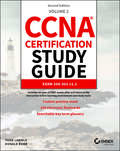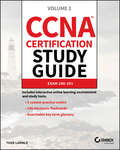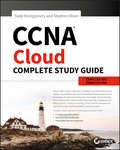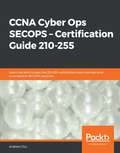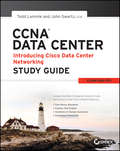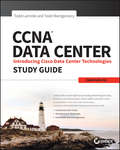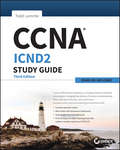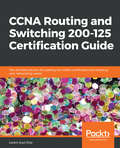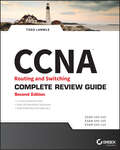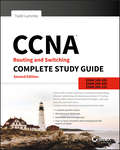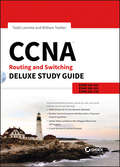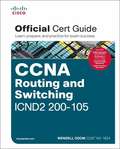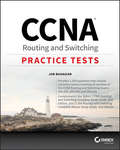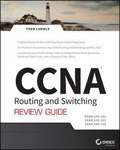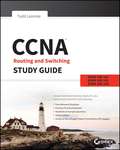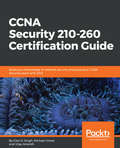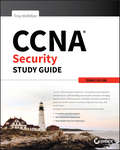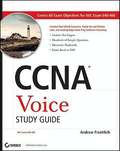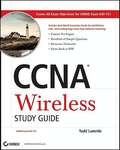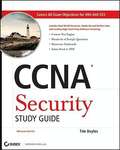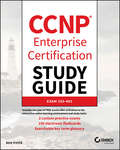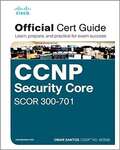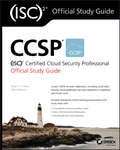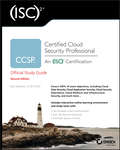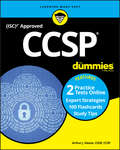- Table View
- List View
CCNA Certification Study Guide Volume 2: Exam 200-301 v1.1 (Sybex Study Guide)
by Todd Lammle Donald RobbYour updated guide to success on the CCNA Certification exam In the newly revised second edition of the CCNA Certification Study Guide – Volume 2: Exam 200-301 v1.1, renowned Cisco educator and network engineer Todd Lammle and Donald Robb deliver a practical and effective test prep and roadmap to the challenging CCNA Certification exam. Volume 2 of the updated Study Guide covers objectives for network fundamentals and access, IP connectivity and services, security fundamentals, automation, programmability, artificial intelligence, and more. You'll also learn about topics like network device security, IPv6, QoS, wireless technologies, wireless controllers, automation, and REST APIs. The CCNA Certification Study Guide comes with one year of free access after activation to a robust set of online study tools designed to assess and advance your exam readiness. You'll find: Up-to-date information relevant to the latest Cisco technologies and job roles An interactive online test bank, including hundreds of practice test questions, flashcards, and a glossary of key terms and definitions Discussions of everything from enhanced switching and ACLs to FHRP, SDN, configuration management, and more Perfect for anyone preparing to pursue the updated CCNA Certification, the CCNA Certification Study Guide – Volume 2 is a must-read for practicing IT professionals looking for a refresher on Cisco networking fundamentals.
CCNA Certification Study Guide: Volume 2 Exam 200-301
by Todd LammleCisco expert Todd Lammle prepares you for the NEW Cisco CCNA certification exam! Cisco, the world leader in network technologies, has released the new Cisco Certified Network Associate (CCNA) exam. This consolidated certification exam tests a candidate’s ability to implement and administer a wide range of modern IT networking technologies. The CCNA Certification Study Guide: Volume 2 Exam 200-301 covers every exam objective,including network components, IP connectivity and routing, network security, virtual networking, and much more. Clear and accuratechapters provide you with real-world examples, hands-on activities, in-depth explanations, and numerous review questions to ensure that you’re fully prepared on exam day. Written by the leading expert on Cisco technologies and certifications, this comprehensive exam guide includes access to the acclaimed Sybex online learning system—an interactive environment featuring practice exams, electronic flashcards, a searchable glossary, a self-assessment test, and video tutorials on critical Cisco networking concepts and technologies. Covers 100% of all CCNA Exam 200-301 objectives Provides accurate and up-to-date information on core network fundamentals Explains a broad range of Cisco networking and IT infrastructure Features learning objectives, chapter summaries, ‘Exam Essentials’ and figures, tables, and illustrations The CCNA Certification Study Guide: Volume 2 Exam 200-301 is the ideal resource for those preparing for the new CCNA certification, as well as IT professionals looking to learn more about Cisco networking concepts and technologies.
CCNA Cloud Complete Study Guide: Exam 210-451 and Exam 210-455
by Stephen Olson Todd MontgomeryIncrease the value of your organization’s cloud network—and invest in your education The Cisco Cloud certification validates the skill set of individuals on industry-leading cloud solutions and best practices, as well as offering job role-based curricula for all levels of an IT staff. CCNA Cloud Complete Study Guide prepares you to take two required exams: 210-451, Understanding Cisco Cloud Fundamentals, and 210-455, Introducing Cisco Cloud Administration. It covers everything you can expect to encounter on the exams and also gives you a year of FREE access to Sybex's superior online interactive learning environment and test bank, including chapter tests, practice exams, a glossary of key terms, and electronic flashcards. Cisco’s CCNA Cloud certification covers cloud characteristics and models, cloud deployment, and basic knowledge of cloud compute, cloud networking, and cloud storage. It also covers cloud infrastructure administration and reporting, chargeback and billing reports, cloud provisioning, cloud systems management and monitoring, and cloud remediation. With thorough coverage, practical instruction, and expert insight, this book provides an ideal resource for Exam 210-451 and Exam 210-455 preparation. • Includes an opening list of exam topics • Provides valuable hands-on exercises • Offers practical real-world examples • Distills in-depth perspective from cloud computing experts This book is the perfect resource for anyone seeking to earn the challenging, but rewarding CCNA Cloud certification.
CCNA Cyber Ops SECOPS – Certification Guide 210-255: Learn the skills to pass the 210-255 certification exam and become a competent SECOPS associate
by Andrew ChuDevelop your cybersecurity knowledge to obtain CCNA Cyber Ops certification and gain professional skills to identify and remove potential threats Key Features Explore different security analysis tools and develop your knowledge to confidently pass the 210-255 SECOPS exam Grasp real-world cybersecurity skills such as threat analysis, event correlation, and identifying malicious activity Learn through mock tests, useful tips, and up-to-date exam questions Book Description Cybersecurity roles have grown exponentially in the IT industry and an increasing number of organizations have set up security operations centers (SOCs) to monitor and respond to security threats. The 210-255 SECOPS exam is the second of two exams required for the Cisco CCNA Cyber Ops certification. By providing you with fundamental knowledge of SOC events, this certification validates your skills in managing cybersecurity processes such as analyzing threats and malicious activities, conducting security investigations, and using incident playbooks. You'll start by understanding threat analysis and computer forensics, which will help you build the foundation for learning intrusion analysis and incident response principles. The book will then guide you through vocabulary and techniques for analyzing data from the network and previous events. In later chapters, you'll discover how to identify, analyze, correlate, and respond to incidents, including how to communicate technical and inaccessible (non-technical) examples. You'll be able to build on your knowledge as you learn through examples and practice questions, and finally test your knowledge with two mock exams that allow you to put what you've learned to the test. By the end of this book, you'll have the skills to confidently pass the SECOPS 210-255 exam and achieve CCNA Cyber Ops certification. What you will learn Get up to speed with the principles of threat analysis, in a network and on a host device Understand the impact of computer forensics Examine typical and atypical network data to identify intrusions Identify the role of the SOC, and explore other individual roles in incident response Analyze data and events using common frameworks Learn the phases of an incident, and how incident response priorities change for each phase Who this book is for This book is for anyone who wants to prepare for the Cisco 210-255 SECOPS exam (CCNA Cyber Ops). If you're interested in cybersecurity, have already completed cybersecurity training as part of your formal education, or you work in Cyber Ops and just need a new certification, this book is for you. The certification guide looks at cyber operations from the ground up, consolidating concepts you may or may not have heard about before, to help you become a better cybersecurity operator.
CCNA Data Center - Introducing Cisco Data Center Networking Study Guide
by Todd Lammle John SwartzA must-have study guide for exam 640-911 on Cisco's Unified Data Center The Cisco Certified Network Associate Data Center certification is Cisco's newest certification, covering the Cisco Unified Data Center technologies. Written by unparalleled author and Cisco authority Todd Lammle, and CCIE John Swartz, this comprehensive study guide is essential reading for anyone preparing to take the 640-911 exam (Introducing Cisco Data Center Networking), providing in-depth coverage of all the exam's objectives. In addition, it offers expanded coverage on key topics reflected on the exam. Addresses understanding basic networking and ethernet technologies Reviews the OSI and DoD model and TCP/IP Transport Layer Covers basic IP routing technologies, layer 2 switching technologies, and routing principles Provides an introduction to Nexus switch as well as how to configure it CCNA Data Center Study Guide offers you access to additional study tools, including bonus practice exams, electronic flashcards, a searchable PDF of a glossary of terms. Plus, you will be able to use the free nexus simulator to perform all the hands-on labs in the book.
CCNA Data Center: Exam 640-916
by Todd Lammle Todd MontgomeryCisco has announced big changes to its certification program. As of February 24, 2020, all current certifications will be retired, and Cisco will begin offering new certification programs. The good news is if you’re working toward any current CCNA certification, keep going. You have until February 24, 2020 to complete your current CCNA. If you already have CCENT/ICND1 certification and would like to earn CCNA, you have until February 23, 2020 to complete your CCNA certification in the current program. Likewise, if you’re thinking of completing the current CCENT/ICND1, ICND2, or CCNA Routing and Switching certification, you can still complete them between now and February 23, 2020. Complete theory and practice for the CCNA Data Center Technologies exam CCNA Data Center, Introducing Cisco Data Center Technologies Study Guide is your comprehensive study guide for exam 640-916. Authors Todd Lammle and Todd Montgomery, authorities on Cisco networking, guide you through 100% of all exam objectives with expanded coverage of key exam topics, and hands-on labs that help you become confident in dealing with everyday challenges. You'll get access to the free Nexus switch simulator that allows you to try your hand at what you've learned without expensive software, plus bonus study aids, such as electronic flashcards, a practice exam, and a searchable PDF glossary of terms. Coverage includes Data Center networking and virtualization, storage networking, unified fabric, Cisco UCS configuration, Data Center services, and much more, for complete exam preparation. This is your guide to study for the entire second (and final) exam required for certification Review networking principles, products, and technologies Understand Nexus 1000V and Data Center virtualization Learn the principles and major configurations of Cisco UCS Practice hands-on solutions you'll employ on the job Prepare for using Cisco's Unified Data Center, which unifies computing, storage, networking, and management resources
CCNA ICND2 Study Guide: Exam 200-105
by Todd LammleReal-world expert preparation for the ICND2, with hands-on labs The CCNA ICND2 Study Guide, 3rd Edition covers 100 percent of all exam 200-105 objectives. Leading networking authority Todd Lammle provides detailed explanations and clear instruction on IP data networks, switching and routing technologies, IPv4 and IPV6 addressing, troubleshooting, security, and more. Dozens of hands-on labs help you gain experience with important tasks, and expert examples and insights drawn from thirty years of networking bring real-world perspective to essential CCNA skills. The Sybex interactive online learning environment provides hundreds of sample questions, a glossary of key terms, and over 100 electronic flashcards to streamline your study time and expand your resources; the pre-assessment test shows you where to focus your efforts, and the practice exam allows you test your level of understanding while there's still time to improve. Need more study tools? Exclusive to this edition, you will receive 30 days of free online video training with almost 20 hours of Routing and Switching from the experts at ITPro TV. The ICND2 is the final exam for the CCNA certification. With 80 percent of the Internet's routers being Cisco technology, this exam is critical for a career in networking. This guide explains everything you need to be confident on exam day. Study 100% of the exam objectives Get essential hands-on experience Access sample questions and flashcards Test your knowledge with a bonus practice exam Be fully prepared for the CCNA ICND2 with the Sybex advantage.
CCNA Routing and Switching 200-125 Certification Guide: The ultimate solution for passing the CCNA certification and boosting your networking career
by Lazaro Laz DiazPrepare yourself for the next generation networking skills and acquire the knowledge needed to secure the routers.Key FeaturesBuild foundational Cisco networking skills and prepare yourself for next-generation network transformationTake practice questions and mock tests to check how prepared you are for the CCNA examGain a strong understanding of network communication with the help of practical examples Book DescriptionCisco Certified Network Associate (CCNA) Routing and Switching is one of the most important qualifications for keeping your networking skills up to date. CCNA Routing and Switching 200-125 Certification Guide covers topics included in the latest CCNA exam, along with review and practice questions. This guide introduces you to the structure of IPv4 and IPv6 addresses and examines in detail the creation of IP networks and sub-networks and how to assign addresses in the network. You will then move on to understanding how to configure, verify, and troubleshoot layer 2 and layer 3 protocols. In addition to this, you will discover the functionality, configuration, and troubleshooting of DHCPv4. Combined with router and router simulation practice, this certification guide will help you cover everything you need to know in order to pass the CCNA Routing and Switching 200-125 exam.By the end of this book, you will explore security best practices, as well as get familiar with the protocols that a network administrator can use to monitor the network.What you will learnGain an in-depth understanding of networking using routers and switchesUnderstand layer 2 technology and its various configurations and connectionsConfigure default, static, and dynamic routingDesign and implement subnetted IPv4 and IPv6 addressing schemesTroubleshoot issues and keep your network secureStudy the importance of VLANs for security and optimizing the bandwidthWho this book is forThis book is for you if you are a network administrator, network technician, or anyone who wants to prepare for CCNA Routing and Switching certification. Basic understanding of networking will help you get the best out of this guide, although sufficient information is provided to those new in this field.
CCNA Routing and Switching Complete Review Guide: Exam 100-105, Exam 200-105, Exam 200-125
by Todd LammleTight, focused CCNA review covering all three exams The CCNA Routing and Switching Complete Review Guide offers clear, concise review for Exams 100-105, 200-105, and 200-125. Written by best-selling certification author and Cisco guru Todd Lammle, this guide is your ideal resource for quick review and reinforcement of key topic areas. This second edition has been updated to align with the latest versions of the exams, and works alongside the Sybex CCNA Routing and Switching Complete Study Guide, 2nd Edition. Coverage includes LAN switching technologies, IP routing, IP services, IPv4 and IPv6 addressing, network device security, WAN technologies, and troubleshooting—providing 100% coverage of all objectives for the CCNA ICND1, ICND2, and Composite exams. The Sybex online learning environment gives you access to additional study tools, including practice exams and flashcards to give you additional review before exam day. Prepare thoroughly for the ICND1, ICND2, and the CCNA Composite exams Master all objective domains, mapped directly to the exams Clarify complex topics with guidance from the leading Cisco expert Access practice exams, electronic flashcards, and more Each chapter focuses on a specific exam domain, so you can read from beginning to end or just skip what you know and get right to the information you need. This Review Guide is designed to work hand-in-hand with any learning tool, or use it as a stand-alone review to gauge your level of understanding. The CCNA Routing and Switching Complete Review Guide, 2nd Edition gives you the confidence you need to succeed on exam day.
CCNA Routing and Switching Complete Study Guide: Exam 100-105, Exam 200-105, Exam 200-125
by Todd LammleNetworking's leading authority joins Sybex for the ultimate CCNA prep guide CCNA Routing and Switching Complete Study Guide, 2nd Edition is your comprehensive review for the CCNA exams. Written by the leading authority on networking technology, this guide covers 100% of all objectives for the latest ICND1, ICND2, and CCNA Composite exams. Hands-on labs help you gain experience in critical procedures and practices, and the network simulator provides a realistic lab environment so you can practice at your own pace. Gain access to the Sybex online learning environment, featuring a robust set of study tools including: practice questions, flashcards, video instruction, and an extensive glossary of terms to help you better prepare for exam day. The pre-assessment test helps you prioritize your study time, and bonus practice exams allow you to test your understanding. Need more practice? Get 20% off a year subscription and free access to premium Cisco Labs-providing hands-on, real-world experience using Cisco Routers, Switches, and Firewalls. Free online video training is also included, with almost forty hours of Routing and Switching guidance from the experts at ITProTV. The CCNA certification is essential to a career in networking, and the exam can be taken in two parts or as a composite. Whichever you choose, this book is your essential guide for complete review. Master IP data network operation Troubleshoot issues and keep the network secure Understand switching and routing technologies Work with IPv4 and IPv6 addressing Full coverage and expert insight makes CCNA Routing and Switching Complete Study Guide your ultimate companion for CCNA prep.
CCNA Routing and Switching Deluxe Study Guide
by Todd Lammle William TedderGet More with the Deluxe EditionThis Deluxe Edition of our bestselling CCNA Study Guide features a ton of bonus materials including more than 1,000 practice questions, author videos, a network simulator that can be used to perform all of the hands-on exercises, and the e-book in multiple formats. The book contains 100% coverage the ICND1, ICND2, and CCNA Composite exams, and features detailed information and examples on crucial Cisco networking topics drawn from Todd Lammle's more than 30 years of real-world experience. This Deluxe Study Guide contains authoritative coverage of all exam topics, including: Operation of IP Data NetworksLAN Switching TechnologiesIP Addressing (IPv4 / IPv6)IP Routing TechnologiesIP ServicesNetwork Device SecurityTroubleshootingLAN Switching Technologies WAN Technologies With all of the bonus materials, this Deluxe Edition of the Sybex CCNA Routing and Switching Study Guide gives you the tools you need to study, practice, and review so that you can approach the exam with confidence.
CCNA Routing and Switching ICND2 200-105: Official Cert Guide
by Wendell OdomMaster Cisco CCNA ICND2 200-105 exam topics. Assess your knowledge with chapter-opening quizzes. Review key concepts with exam preparation tasks. Practice with realistic exam questions on the CD-ROM.
CCNA Routing and Switching Practice Tests: Exam 100-105, Exam 200-105, and Exam 200-125
by Jon BuhagiarPreview exam day with 1500 questions tailored to the exam domains CCNA Routing and Switching Practice Tests is your ultimate tool for exam success and compliments the Sybex Deluxe Study Guides and Study Guides for the CCENT and CCNA. Whether you're taking the 200-15 Composite Exam or the two-part 100-105 and 200-105 exams, this book gives you the practice you need to study smarter. Seven completely unique 200-question practice tests cover the seven CCNA Routing and Switching objective domains, and two additional unique 50-question practice exams provide even more opportunity to find areas where further review is needed. These 1500 questions cover everything you'll see on the exam—network fundamentals; LAN switching technologies; routing technologies; WAN technologies; and infrastructure services, security, and management—so you can avoid any exam-day surprises. Fully aligned with the latest versions of the exams, this book helps you focus your study time and remove uncertainties so you can face the exam with confidence. The CCNA Routing and Switching exams test your working knowledge of IP data networks, addressing, routing, and services; network device security; troubleshooting, and more. These practice tests cover it all to help you discover what you already know, what you still need to learn, and what to expect on exam day. Get a preview of the types of questions you'll see on the exam Pinpoint areas in need of review Focus your study time for better results Gauge your readiness for any CCNA exam The CCNA exams cover a broad range of routing and switching topics, and the questions can get fairly in-depth. Practice makes perfect, and practice tests tailored to each of the seven exam domains provide an ideal opportunity to ensure your own top-notch performance. When you're ready to get serious about CCNA certification, CCNA Routing and Switching Practice Tests are your solution for ultimate exam-day confidence.
CCNA Routing and Switching Review Guide
by Todd LammleTodd Lammle's focused, concise review guide, updated for the latest CCNA examsCCNA is one of the most sought after certifications for IT professionals. If you're preparing for the CCNA Routing and Switching certification, this Sybex review guide offers the best quick review available. Organized by exam objective, it's the perfect supplement to other learning tools, including the Sybex CCNA Routing and Switching Study Guide (ISBN: 9781118749616). All exam topics from exams 100-101, 200-101, and 200-120 are thoroughly covered, and additional study materials including bonus exams, electronic flashcards, and a searchable glossary of terms are also available.Organized by exam objectives, this Sybex review guide provides a thorough and intensive review of all topics required for the CCNA Routing and Switching certification examsLead author Todd Lammle is a Cisco networking authority and the bestselling author of numerous Cisco exam-prep booksCovers exams 100-101, 200-101, and 200-120, and is a perfect companion to Sybex's CCNA Routing and Switching Study GuideAdditional study materials are available, including bonus practice exams, electronic flashcard questions, and a glossary of terms in searchable PDF formUsing the CCNA Routing and Switching Review Guide will boost your confidence as you approach exams 100-101, 200-101, and 200-120.
CCNA Routing and Switching Study Guide
by Todd LammlePrepare for the new CCNA exams with this Todd Lammle study guideCisco author, speaker, and trainer Todd Lammle is considered the authority on all things networking, and his books have sold almost a million copies worldwide. This all-purpose CCNA study guide methodically covers all the objectives of the ICND1 (100-101) and ICND2 (200-101) exams as well as providing additional insight for those taking CCNA Composite (200-120) exam. It thoroughly examines operation of IP data networks, LAN switching technologies, IP addressing (IPv4/IPv6), IP routing technologies, IP services, network device security, troubleshooting, and WAN technologies.Valuable study tools such as a companion test engine that includes hundreds of sample questions, a pre-assessment test, and multiple practice exams. Plus, you'll also get access to hundreds of electronic flashcards, author files, and a network simulator.CCNA candidates may choose to take either the ICND1(100-101) and ICND2 (200-101) exams or the CCNA Composite exam (200-120); this study guide covers the full objectives of all threeWritten by bestselling Sybex study guide author Todd Lammle, an acknowledged authority on all things CiscoCovers essential Cisco networking topics such as operating an IP data network, IP addressing, switching and routing technologies, troubleshooting, network device security, and much moreIncludes a comprehensive set of study tools including practice exams, electronic flashcards, comprehensive glossary of key terms, videos, and a network simulator that can be used with the book's hands-on labsBonus Content: Access to over 40 MicroNugget videos from CBT NuggetsCCNA Routing and Switching Study Guide prepares you for CCNA certification success.
CCNA Security 210-260 Certification Guide: Build your knowledge of network security and pass your CCNA Security exam (210-260)
by Glen D. Singh Michael Vinod G Vijay AnandhBecome a Cisco security specialist by developing your skills in network security and explore advanced security technologiesKey FeaturesEnhance your skills in network security by learning about Cisco’s device configuration and installationUnlock the practical aspects of CCNA security to secure your devicesExplore tips and tricks to help you achieve the CCNA Security 210-260 CertificationBook DescriptionWith CCNA Security certification, a network professional can demonstrate the skills required to develop security infrastructure, recognize threats and vulnerabilities to networks, and mitigate security threats. The CCNA Security 210-260 Certification Guide will help you grasp the fundamentals of network security and prepare you for the Cisco CCNA Security Certification exam.You’ll begin by getting a grip on the fundamentals of network security and exploring the different tools available. Then, you’ll see how to securely manage your network devices by implementing the AAA framework and configuring different management plane protocols.Next, you’ll learn about security on the data link layer by implementing various security toolkits. You’ll be introduced to various firewall technologies and will understand how to configure a zone-based firewall on a Cisco IOS device. You’ll configure a site-to-site VPN on a Cisco device and get familiar with different types of VPNs and configurations. Finally, you’ll delve into the concepts of IPS and endpoint security to secure your organization’s network infrastructure.By the end of this book, you’ll be ready to take the CCNA Security Exam (210-260).What you will learnGrasp the fundamentals of network securityConfigure routing protocols to secure network devicesMitigate different styles of security attacks using Cisco devicesExplore the different types of firewall technologiesDiscover the Cisco ASA functionality and gain insights into some advanced ASA configurationsImplement IPS on a Cisco device and understand the concept of endpoint securityWho this book is forCCNA Security 210-260 Certification Guide can help you become a network security engineer, a cyber security professional, or a security administrator. You should have valid CCENT or CCNA Routing and Switching certification before taking your CCNA Security exam.
CCNA Security Study Guide: Exam 210-260
by Troy McMillanLay the foundation for a successful career in network security CCNA Security Study Guide offers comprehensive review for Exam 210-260. Packed with concise explanations of core security concepts, this book is designed to help you successfully prepare for the exam. Expert instruction guides you through critical concepts relating to secure network infrastructure, access management, VPN encryption, Firewalls, intrusion prevention and more, with complete coverage of the CCNA exam objectives. Practical examples allow you to apply your skills in real-world scenarios, helping you transition effectively from "learning" to "doing". You also get access to the Sybex online learning environment, featuring the tools you need to maximize your study time: key terminology and flash cards allow you to study anytime, anywhere, while chapter tests and practice exams help you track your progress and gauge your readiness along the way. The CCNA Security certification tests your knowledge of secure network installation, monitoring, and troubleshooting using Cisco security hardware and software solutions. When you're ready to get serious about preparing for the exam, this book gives you the advantage of complete coverage, real-world application, and extensive learning aids to help you pass with confidence. Master Cisco security essentials, standards, and core technologies Work through practical examples drawn from real-world examples Track your progress with online study aids and self-tests Develop critical competencies in maintaining data integrity, confidentiality, and availability Earning your CCNA Security certification validates your abilities in areas that define careers including network security, administrator, and network security support engineer. With data threats continuing to mount, the demand for this skill set will only continue to grow—and in an employer's eyes, a CCNA certification makes you a true professional. CCNA Security Study Guide is the ideal preparation resource for candidates looking to not only pass the exam, but also succeed in the field.
CCNA Voice Study Guide
by Andrew FroehlichThe ultimate guide to the new CCNA voice network administrator certification examThe new CCNA Voice exam tests candidates on their ability to implement a Cisco VoIP solution. Network administrators of voice systems will appreciate that the CCNA Voice Study Guide focuses completely on the information required by the exam.Along with hands-on labs and an objective map showing where each objective is covered, this guide includes a CD with the Sybex Test Engine, flashcards, and entire book in PDF format.The new CCNA Voice certification will be valuable for administrators of voice network systems using Cisco VoIP solutionsFrom Sybex, the leading CCNA publisher, this guide offers in-depth coverage of every exam objective and the technology developed by Cisco for VoIP systemsCovers the components of the Cisco Unified Communications Architecture as well as PSTN and VoIP components and technologiesShows how to configure gateways, voice ports, and dial peersDemonstrates how to configure a Cisco network to support VoIP and implement voicemailCD-ROM includes the Sybex Test Engine, flashcards, and entire book in PDF formatCCNA Voice Study Guide will thoroughly prepare candidates for the new CCNA Voice certification.Note: CD-ROM/DVD and other supplementary materials are not included as part of eBook file.
CCNA Wireless Study Guide
by Todd LammleA complete guide to the CCNA Wireless exam by leading networking authority Todd Lammle The CCNA Wireless certification is the most respected entry-level certification in this rapidly growing field. Todd Lammle is the undisputed authority on networking, and this book focuses exclusively on the skills covered in this Cisco certification exam. The CCNA Wireless Study Guide joins the popular Sybex study guide family and helps network administrators advance their careers with a highly desirable certification. The CCNA Wireless certification is the most respected entry-level wireless certification for system administrators looking to advance their careers Written by Todd Lammle, the leading networking guru and author of numerous bestselling certification guides Provides in-depth coverage of every exam objective and the technology developed by Cisco for wireless networking Covers WLAN fundamentals, installing a basic Cisco wireless LAN and wireless clients, and implementing WLAN security Explains the operation of basic WCS, basic WLAN maintenance, and troubleshooting Companion CD includes the Sybex Test Engine, flashcards, and entire book in PDF format Includes hands-on labs, end-of-chapter review questions, Exam Essentials overview, Real World Scenarios, and a tear-out objective map showing where each exam objective is covered The CCNA Wireless Study Guide prepares any network administrator for exam success. Note: CD-ROM/DVD and other supplementary materials are not included as part of eBook file.
CCNA® Security Study Guide
by Tim BoylesA complete study guide for the new CCNA Security certification exam In keeping with its status as the leading publisher of CCNA study guides, Sybex introduces the complete guide to the new CCNA security exam. The CCNA Security certification is the first step towards Cisco's new Cisco Certified Security Professional (CCSP) and Cisco Certified Internetworking Engineer-Security. CCNA Security Study Guide fully covers every exam objective. The companion CD includes the Sybex Test Engine, flashcards, and a PDF of the book. The CCNA Security certification is the first step toward Cisco's new CCSP and Cisco Certified Internetworking Engineer-Security Describes security threats facing modern network infrastructures and how to mitigate threats to Cisco routers and networks using ACLs Explores implementing AAA on Cisco routers and secure network management and reporting Shows how to implement Cisco IOS firewall and IPS feature sets plus site-to-site VPNs using SDM CD includes the Sybex Test Engine, flashcards, and the book in PDF format With hands-on labs and end-of-chapter reviews, CCNA Security Study Guide thoroughly prepares you for certification. Note: CD-ROM/DVD and other supplementary materials are not included as part of eBook file.
CCNP Enterprise Certification Study Guide: Exam 350-401
by Ben PiperThe practical and conceptual knowledge you need to attain CCNP Enterprise certification From one of the most trusted study guide publishers comes CCNP Enterprise Certification Study Guide: Exam 350-401. This guide helps you develop practical knowledge and best practices for critical aspects of enterprise infrastructure so you can gain your CCNP Enterprise certification. If you’re hoping to attain a broader range of skills and a solid understanding of Cisco technology, this guide will also provide fundamental concepts for learning how to implement and operate Cisco enterprise network core technologies. By focusing on real-world skills, each chapter prepares you with the knowledge you need to excel in your current role and beyond. It covers emerging and industry-specific topics, such as SD-WAN, network design, wireless, and automation. This practical guide also includes lessons on: ● Automation ● Network assurance ● Security ● Enterprise infrastructure ● Dual-stack architecture ● Virtualization In addition to helping you gain enterprise knowledge, this study guidecan lead you toward your Cisco specialist certification. When you purchase this guide, you get access to the information you need to prepare yourself for advances in technology and new applications, as well as online study tools such as: ● Bonus practice exams ● Pre-made flashcards ● Glossary of key terms ● Specific focus areas Expand your skillset and take your career to the next level with CCNP Enterprise Certification Study Guide.
CCNP and CCIE Security Core SCOR 350-701 Official Cert Guide
by Omar SantosCCNP and CCIE Security Core SCOR 350-701 Official Cert Guide presents you with an organized test preparation routine using proven series elements and techniques. “Do I Know This Already?” quizzes open each chapter and allow you to decide how much time you need to spend on each section. Exam topic lists make referencing easy. Chapter-ending Exam Preparation Tasks help you drill on key concepts you must know thoroughly. <p><p> CCNP and CCIE Security Core SCOR 350-701 Official Cert Guide, from Cisco Press allows you to succeed on the exam the first time and is the only self-study resource approved by Cisco. Best-selling author and leading security engineer Omar Santos shares preparation hints and test-taking tips, helping you identify areas of weakness and improve both your conceptual knowledge and hands-on skills.
CCSP (ISC)2 Certified Cloud Security Professional Official Study Guide
by Ben Malisow O'HaraThe only official study guide for the new CCSP exam CCSP (ISC)2 Certified Cloud Security Professional Official Study Guide is your ultimate resource for the CCSP exam. As the only official study guide reviewed and endorsed by (ISC)2, this guide helps you prepare faster and smarter with the Sybex study tools that include pre-test assessments that show you what you know, and areas you need further review. Objective maps, exercises, and chapter review questions help you gauge your progress along the way, and the Sybex interactive online learning environment includes access to a PDF glossary, hundreds of flashcards, and two complete practice exams. Covering all CCSP domains, this book walks you through Architectural Concepts and Design Requirements, Cloud Data Security, Cloud Platform and Infrastructure Security, Cloud Application Security, Operations, and Legal and Compliance with real-world scenarios to help you apply you skills along the way. The CCSP is the latest credential from the (ISC)2 and the Cloud Alliance, designed to show employers that you have what it takes to keep their organization safe in the cloud. Learn the skills you need to be confident on exam day and beyond. Review 100% of all CCSP exam objectives Practice applying essential concepts and skills Access the industry-leading online study tool set Test your knowledge with bonus practice exams and more As organizations become increasingly reliant on cloud-based IT, the threat to data security looms larger. Employers are seeking qualified professionals with a proven cloud security skillset, and the CCSP credential brings your resume to the top of the pile. CCSP (ISC)2 Certified Cloud Security Professional Official Study Guide gives you the tools and information you need to earn that certification, and apply your skills in a real-world setting.
CCSP (ISC)2 Certified Cloud Security Professional Official Study Guide
by Ben MalisowThe only official study guide for the new CCSP exam CCSP (ISC)2 Certified Cloud Security Professional Official Study Guide is your ultimate resource for the CCSP exam. As the only official study guide reviewed and endorsed by (ISC)2, this guide helps you prepare faster and smarter with the Sybex study tools that include pre-test assessments that show you what you know, and areas you need further review. Objective maps, exercises, and chapter review questions help you gauge your progress along the way, and the Sybex interactive online learning environment includes access to a PDF glossary, hundreds of flashcards, and two complete practice exams. Covering all CCSP domains, this book walks you through Architectural Concepts and Design Requirements, Cloud Data Security, Cloud Platform and Infrastructure Security, Cloud Application Security, Operations, and Legal and Compliance with real-world scenarios to help you apply your skills along the way. The CCSP is the latest credential from (ISC)2 and the Cloud Security Alliance, designed to show employers that you have what it takes to keep their organization safe in the cloud. Learn the skills you need to be confident on exam day and beyond. Review 100% of all CCSP exam objectives Practice applying essential concepts and skills Access the industry-leading online study tool set Test your knowledge with bonus practice exams and more As organizations become increasingly reliant on cloud-based IT, the threat to data security looms larger. Employers are seeking qualified professionals with a proven cloud security skillset, and the CCSP credential brings your resume to the top of the pile. CCSP (ISC)2 Certified Cloud Security Professional Official Study Guide gives you the tools and information you need to earn that certification, and apply your skills in a real-world setting.
CCSP For Dummies with Online Practice
by DeaneSecure your CSSP certification CCSP is the world’s leading Cloud Security certification. It covers the advanced technical skills and knowledge to design, manage, and secure data, applications, and infrastructure in the cloud using best practices, policies, and procedures. If you’re a cloud security professional seeking your CSSP certification, this book is a perfect way to prepare for the exam. Covering in detail all six domains, the expert advice in this book gives you key information you'll need to pass the exam. In addition to the information covered on the exam, you'll get tips on setting up a study plan, tips for exam day, and access to an online test bank of questions. Key information for all six exam domains Test -taking and exam day tips and tricks Free online practice questions and flashcards Coverage of the core concepts From getting familiar with the core concepts to establishing a study plan, this book is all you need to hang your hat on that certification!
